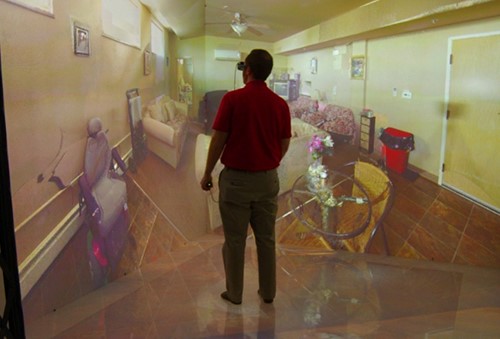BTN.com LiveBIG Staff, February 29, 2016
During football and basketball games, BTN LiveBIG will spotlight notable examples of research, innovation and community service from around the conference. In-Game stories will provide more background on these features, and the opportunity to view the videos again.
To describe different levels of human thought, the ancient Greek thinker Plato came up with the Allegory of the Cave. Essentially, he described a metaphorical situation in which some people (the ones with true knowledge) could see the world as it really is. But many more only experienced life as a series of shadows upon a cave wall, never really understanding what was going on.
Plato?s idea helped inform the creation of another kind of ?CAVE? at the University of Wisconsin - the Cave Automatic Virtual Environment, which provides a wide range of simulated realities for the pursuit of knowledge.
?This allegory reflects back to this idea of the CAVE,? said Kevin Ponto, an assistant professor at Wisconsin. ?We?re recreating this other reality through projection. The CAVE is a room where ? the floor, the wall, the ceiling - it?s all 3-D projection. We can recreate any kind of an environment in the past or an environment in the future. It?s just right there in front of you.?
Ponto is a member of the faculty at the Design Studies Department in the university?s School of Human Ecology, but also serves as a key member of the CAVE team within the Wisconsin Institute for Discovery?s Living Environments Laboratory.
Until recently, virtual reality (VR) was mainly the province of large organizations with vast resources - think the U.S. Armed Forces, Boeing, Ford and ExxonMobil - that wanted to test products and processes in certain environments. But recent technology advances have made this platform much more accessible and affordable, Ponto explained.
?All of a sudden, we?ve seen new types of applications bounce up for this type of technology,? he added. ?The video-game industry has become very interested in virtual-reality technology as a new means for creating user experiences.
?We?ve seen people really interested in this field as a new means of communication. [It?s the] ultimate empathy machine because you can take people to different parts of the world and really convey what these areas actually look like.?
One of the advances that Ponto and other researchers are working on for the CAVE is physical sensations that correspond with what?s happening in a VR environment.
[btn-post-package]?We?ve been looking at muscle signals, so that you actually reach your hand out and pick up objects and you have to lift them with a force you would need for a normal object,? he explained. ?We can pick them up, we can move them around, we can drop them, we can kick them, we can throw them. It?s very fun.?
Developments like this have Ponto excited about what the future of VR holds for everyone, not just researchers and academics.
?I think that we?re just on the cusp of seeing where this technology is going to go into the consumer market,? he said. ?It?s harder to know exactly what directions, but it?s interesting to really think big about it.?
By Brian Summerfield








